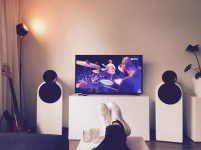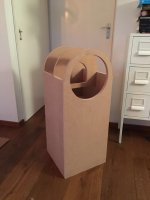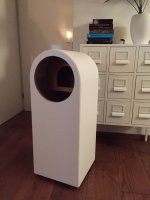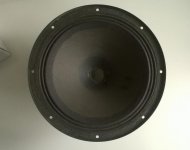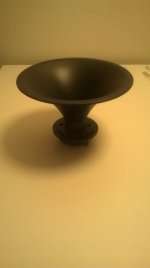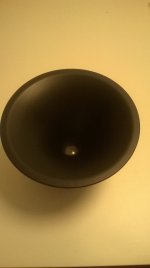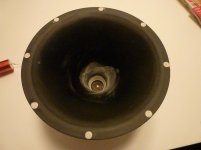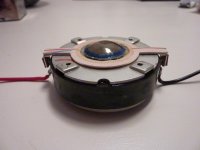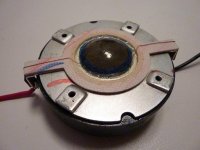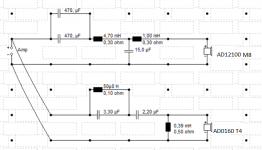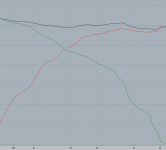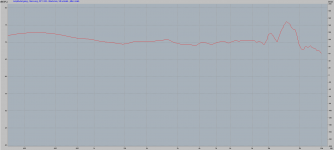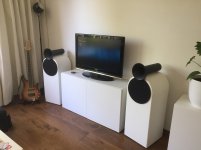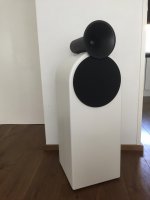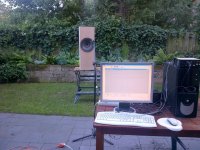Philips "Gouw", vintage prestige project (AD12100/M8 & AD0160/T4)
This thread will be to showcase my prestige project with a few old Philips drivers. It is an ode to Piet Gouw, who was the productmanager at Philips in the 70's and 80's, he was also responsible for the launch of the Motional Feed Back loudspeaker back then.
The drivers in question are the AD12100/M8 and the AD0160/T4, classic drivers for sure!
It all started about 10 years ago and I had several ideas about what to do with these drivers, you can read some of it in this old thread.
Brutus: concept with vintage Philips drivers
So, last year I finally finished the project and all I can say is that it's the best sounding system I've designed / build to date.
Below a few pictures of my setup, these pups are running for a year now and I'm still amazed at how dynamic and lively they sound. The amp I use is a small hybrid amp from Dynavox, the VR-307BT, it's only 25 watts per channel but it's more then enough to drive these loudspeakers which have an efficiency of approx. 93dB w/mtr.
More on the build and measurements on a follow up post 😎
This thread will be to showcase my prestige project with a few old Philips drivers. It is an ode to Piet Gouw, who was the productmanager at Philips in the 70's and 80's, he was also responsible for the launch of the Motional Feed Back loudspeaker back then.
The drivers in question are the AD12100/M8 and the AD0160/T4, classic drivers for sure!
It all started about 10 years ago and I had several ideas about what to do with these drivers, you can read some of it in this old thread.
Brutus: concept with vintage Philips drivers
So, last year I finally finished the project and all I can say is that it's the best sounding system I've designed / build to date.
Below a few pictures of my setup, these pups are running for a year now and I'm still amazed at how dynamic and lively they sound. The amp I use is a small hybrid amp from Dynavox, the VR-307BT, it's only 25 watts per channel but it's more then enough to drive these loudspeakers which have an efficiency of approx. 93dB w/mtr.
More on the build and measurements on a follow up post 😎
Attachments
Last edited:
The AD12100/M8 whith the whizzer removed.
This modification was necessary to improve the mid response.
The whizzer cone created a huge rise in the response starting at 1.5khz making it very hard to create a smooth transition between both drivers. Whitout the whizzer the response is very smooth in the mids, no break-ups or other anomalies (sorry, no pics of these measurements, I lost most of them when my PC crashed). Still, the response is rising slightly from 1khz and up so it was not possible to use a 2nd order lowpass on the AD12100/M8.
This modification was necessary to improve the mid response.
The whizzer cone created a huge rise in the response starting at 1.5khz making it very hard to create a smooth transition between both drivers. Whitout the whizzer the response is very smooth in the mids, no break-ups or other anomalies (sorry, no pics of these measurements, I lost most of them when my PC crashed). Still, the response is rising slightly from 1khz and up so it was not possible to use a 2nd order lowpass on the AD12100/M8.
Attachments
Last edited:
A few pics of the AD0160/T4 and the Dayton 8" Tractrix horn.
The AD0160/T4 received some aditional damping (self-sticking felt knob) behind the dome to slightly improve it's response.
The AD0160/T4 received some aditional damping (self-sticking felt knob) behind the dome to slightly improve it's response.
Attachments
Schematic of the cross-over.
Crossover point is 1.4khz (see picture of response), at first it seems a bit low for the ol'dome tweeter but the 8" horn adds a massive bump of approx 15dB between 1 and 2.5khz. The highpass has to remove all that so powerhandling and distortion will be low enough at the crossover point.
I also added two "tricks", the first is the 970uf in series with the AD12100/M8. It adds approx 2dB in the 30-40hz range and reduces the slight bump around 100hz with 1dB (enclosure is sealed).
The 2nd trick is the parallel LC in series with the tweeter, it eliminates the (infamous) peak at 14khz, typical for the AD0160 tweeter. This really improves the high end of this tweeter, it removes the harshness without sacrificing dynamics and detail.
Crossover point is 1.4khz (see picture of response), at first it seems a bit low for the ol'dome tweeter but the 8" horn adds a massive bump of approx 15dB between 1 and 2.5khz. The highpass has to remove all that so powerhandling and distortion will be low enough at the crossover point.
I also added two "tricks", the first is the 970uf in series with the AD12100/M8. It adds approx 2dB in the 30-40hz range and reduces the slight bump around 100hz with 1dB (enclosure is sealed).
The 2nd trick is the parallel LC in series with the tweeter, it eliminates the (infamous) peak at 14khz, typical for the AD0160 tweeter. This really improves the high end of this tweeter, it removes the harshness without sacrificing dynamics and detail.
Attachments
Below is the response from 300hz - 20khz (1mtr/15-degrees off-axis (tweeter axis))
There is a slight bump between 300hz - 1khz, I could have reduced that by adding additional components but my "ears" didn't notice it during listening.
The mids (1 - 9khz) are a straight line, nothing to complain here. Listening tests show that voices and acoustic instruments sound very life like.
The peak at 13khz was audible, hihats and crashes could sound a bit to forward, the decay diagram showed that this peak wasn't that bad because there was no real ringing visible. Still, I added the LC in series with the tweeter to remove the bump wich made the high-end less forward and more smooth and transparant.
There is a slight bump between 300hz - 1khz, I could have reduced that by adding additional components but my "ears" didn't notice it during listening.
The mids (1 - 9khz) are a straight line, nothing to complain here. Listening tests show that voices and acoustic instruments sound very life like.
The peak at 13khz was audible, hihats and crashes could sound a bit to forward, the decay diagram showed that this peak wasn't that bad because there was no real ringing visible. Still, I added the LC in series with the tweeter to remove the bump wich made the high-end less forward and more smooth and transparant.
Attachments
Great looking speaker. Wonderful sentiment/nostalgia behind the design too.
Thank you!
Yes, I always wanted to show that it's possible to create something very special with some of the ol' Philips stuff. They made some really great drivers in the 70's and 80's. Piet Gouw was responsible for a lot of that great stuff. I wrote him an email like more then 10 years ago to ask what went "wrong" at the Philips audio department in the mid 80's and he gave me a very honest answer that showed to me the passion he had for quality products.
- Status
- Not open for further replies.
- Home
- Loudspeakers
- Multi-Way
- Philips "Gouw", vintage prestige project
